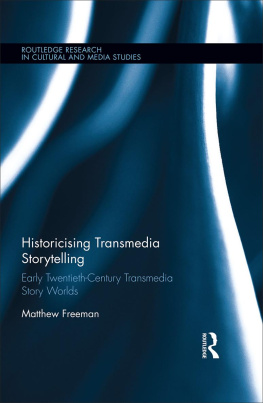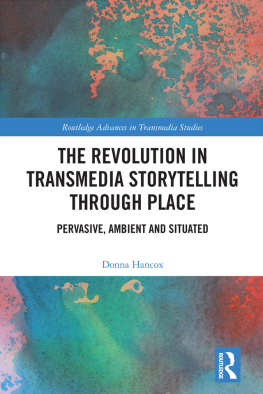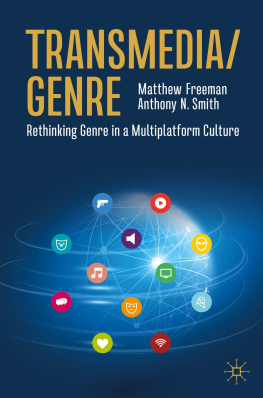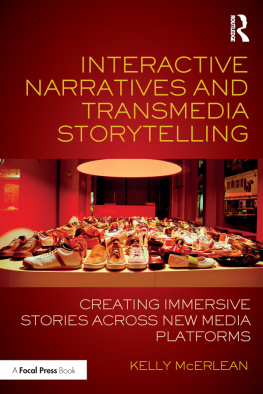Transmedia Storytelling
Transmedia Storytelling
The Librarians Guide
Amanda S. Hovious

Copyright 2016 by Amanda S. Hovious
All rights reserved. No part of this publication may be reproduced, stored in a retrieval system, or transmitted, in any form or by any means, electronic, mechanical, photocopying, recording, or otherwise, except for the inclusion of brief quotations in a review, without prior permission in writing from the publisher.
Library of Congress Cataloging-in-Publication Data
Names: Hovious, Amanda S., author.
Title: Transmedia storytelling : the librarians guide / Amanda S. Hovious.
Description: Santa Barbara, CA : Libraries Unlimited, an imprint of ABC-CLIO, LLC, [2016] | Includes bibliographical references and index.
Identifiers: LCCN 2015025227 | ISBN 9781440838484 (paperback) | ISBN 9781440838491 (ebook)
Subjects: LCSH: School librariesActivity programs. | Digital storytelling. | Interactive multimedia. | Storytelling in education. | Mass media in education. | Technological literacyStudy and teachingActivity programs. | Childrens librariesActivity programs. | Young adults librariesActivity programs. | BISAC: LANGUAGE ARTS & DISCIPLINES / Library & Information Science / School Media. | LANGUAGE ARTS & DISCIPLINES / Library & Information Science / Collection Development. | LANGUAGE ARTS & DISCIPLINES / Library & Information Science / General.
Classification: LCC Z675.S3 .H675 2016 | DDC 027.62/51dc23
LC record available at http://lccn.loc.gov/2015025227
ISBN: 978-1-4408-3848-4
EISBN: 978-1-4408-3849-1
20 19 18 17 161 2 3 4 5
This book is also available on the World Wide Web as an eBook.
Visit www.abc-clio.com for details.
Libraries Unlimited
An Imprint of ABC-CLIO, LLC
ABC-CLIO, LLC
130 Cremona Drive, P.O. Box 1911
Santa Barbara, California 931161911
This book is printed on acid-free paper 
Manufactured in the United States of America
Contents
Are you interested in innovative programming ideas for your library that connect literacy learning to technology? Then you have come to the right place! Transmedia storytellingstorytelling across multiple media platformsis a powerful tool for motivating, engaging, and inspiring library users of all ages to read, make, and learn.
From transmedia story times to transmedia fiction clubs to transmedia-inspired library instruction and beyond, this book takes a theory-to-practice approach, resulting in a guide that explores the literacy-rich learning values of transmedia storytelling in (last two chapters), through transmedia storytelling program ideas that can be implemented in either public or school libraries. The goal of this book is to provide a one-stop shop for everything librarians (and teachers) need to know about transmedia storytelling, along with transmedia-based activities that not only support 21st-century literacies and learning but are also well aligned to 21st-century learning standardsmaking them both library-ready and classroom adaptable.
Following is an overview for each chapter:
lays the groundwork by defining transmedia storytelling and describing successful examples of projects that help bring the concept into sharper focus.
makes connections between literacy theories and the characteristics of transmedia storytelling to explain how transmedia literacy practices can be seen as a new way of reading.
explains how the elements of both storytelling and gameplay make transmedia storytelling a powerful learning tool.
describes how libraries can make transmedia storytelling discoverable, and by doing so can support and promote their missions and goals.
presents seven different types of transmedia storytelling program ideas, with multiple examples and step-by-step instructions.
provides templates and guidance for the transmedia technology planning process.
My inspiration for this book comes from the transmedia storytelling project, Inanimate Alice, which I discovered in a game-based learning course. I immediately became smitten with its beauty and literary value, and was equally mesmerized by its literacy-rich affordances. That discovery led to an interest in using projects like Inanimate Alice for learning activities within classrooms and libraries.
While first and foremost I define myself as a librarian, I am also a professionally trained instructional designer, and have found those skills incredibly useful for the design and development of the library programs in this book. My hope is that librarians and educators who read this book gain a better understanding of the value of transmedia storytelling as a literacy and learning tool, and are inspired to experiment with the transmedia storytelling program ideas in this book within their own libraries and classrooms.
Origins of the Concept The Seven Principles of Transmedia Storytelling Transmedia Storytelling Types Transmedia Storytelling Genres
Transmedia storytelling takes the traditional art of storytelling to a whole new level, delivering a fictional story across multiple media platformswhether physical, digital, or bothto create a truly immersive storytelling experience. This chapter explores the origins of transmedia storytelling, the principles that define it, and the different types of transmedia narratives; and ends with case studies of exemplary projects that help to further illustrate the concept of transmedia storytelling.
Origins of the Concept
Media studies scholar Henry Jenkins (2003) introduced the concept of transmedia storytelling in a Technology Review article about the collaborative effort of Hollywood and the gaming industry to develop content that could expand the entertainment experience across multiple media platforms. In his definitive work, Convergence Culture (2006), Jenkins defined a transmedia story as one that unfolds across multiple media platforms, with each new text making a distinctive and valuable contribution to the whole (9596). Other scholars have taken different approaches to defining transmedia storytelling. Walker (2004) described transmedia storytelling as a theory of distributed narrativesnarratives that explode the work altogether, sending fragments and shards across media, through the network and sometimes into the physical spaces that we live in (1). Dena (2004) used the term cross-media storytelling, emphasizing the central importance of the user and the role of the storyline in the users activity. Rose (2015) proposed the idea of immersive media, focusing on immersion as a key feature of transmedia storytelling. All these definitions reflect different aspects of transmedia storytelling.
Efforts to expand entertainment experiences across multiple media platforms have long been commonplace in the world of childrens entertainment with the merchandising of character-based games, toys, and books (e.g., Pokemon). Today, Hollywood has fully embraced the concept of transmedia storytelling as demonstrated in franchises such as the Lord of the Rings, where the characters of Middle Earth were spun off from the books into blockbuster movies, video games, virtual worlds, music, and merchandiseall of which fuel and satisfy the unquenchable thirst of die-hard fans of the trilogy. Transmedia storytelling is more than just the spin-off of a story or set of characters from one media platform to another though. Each media platform expands and experiments with the story or characters in such a way that inspires the audience to want to further explore different avenues or angles of the story. At the same time, each media platform stands alone, so that the audience may enter the story world at any one point, whether book, movie, or video game. Taken together, the multiple media outlets create a fully immersive storytelling experience that motivates fans to explore all the story worlds (Jenkins 2006).










